#black gungnir saga
Text
Black Gungnir Another!Hibiki returns with a lot of edge!!!

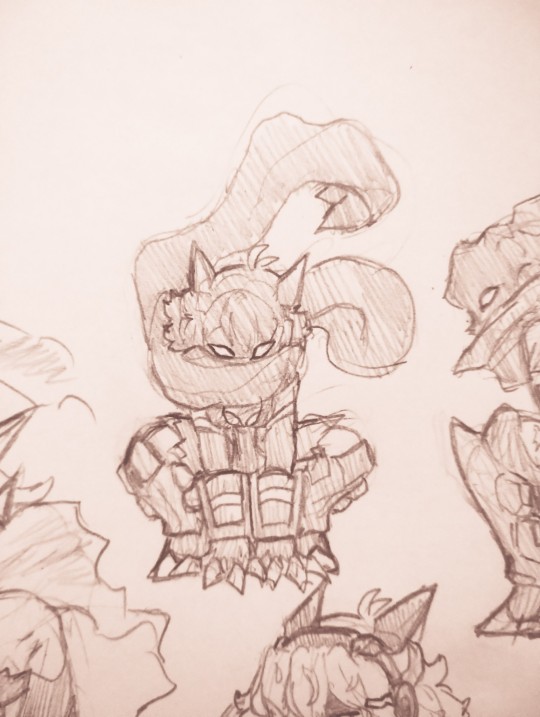
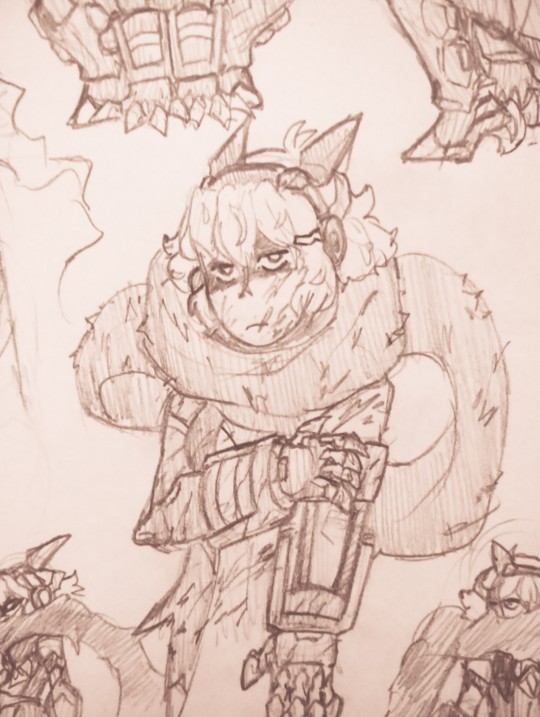
Some flowy action poses too because I wanted to do some practice on that and Hibiki fits that need perfectly.


And an attempt at pushing the Black Gungnir's design into a XV analogue, taking major influence from the Ignite Module suit. Plus leg blade, because leg blades are cool and I really wanted to differentiate between canon Hibiki's grounded punch-based fighting style by giving Another!Hibiki a floaty kick-based style, since y'know, she's self taught!
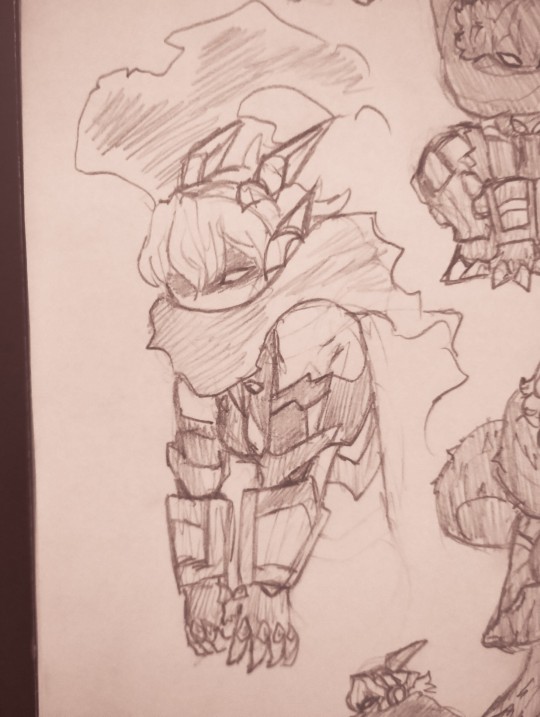
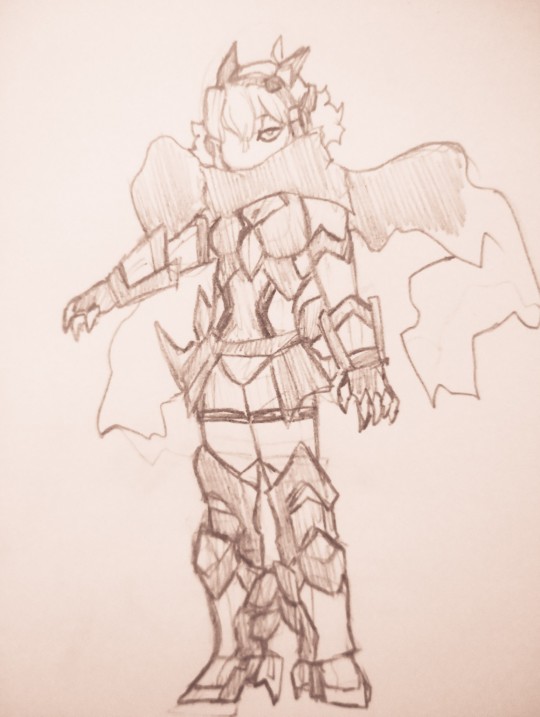

The shadow scarf idea comes from the Burning X-Drive and Ignite X-Drive, mostly because it's cool but also I think it would highlight her high-speed style!
#symphogear#senki zesshou symphogear#hibiki tachibana#symphogear xdu#edgebikki#my art#black gungnir saga
38 notes
·
View notes
Note
Hey there Bedlam, I have one question: do you have any references of how Loki's hairstyle looks on Yonder Hill, I have zero imagination xD sorry! If you have, can you send me one? my chat is open if you happend to find a pic :D thanks and also a reference for Mistilteinn (i have a good day learning that it means Mistletoe and that it was some Legendary sword from a saga) :D
He shuffles through a couple of different hairstyles! I think I said at some point somewhere that I was looking at a lot of Lagertha's hairstyles from the History Channel's Vikings, as well as the other women from the show -- those kinds of faux-historical braids that you see in a lot of historical and high fantasy films/TV. (I want to say we first start seeing them show up in genre films/TV with LotR and the elves there, but they could have shown up earlier and I just don't remember.) (We do see them on characters in Asgard (and Thor has braids in his hair, I think from TDW onwards, so, like, I didn't do this completely out of nowhere. ) None of his hairstyles are based on anything specific (well, when his hair is just noted as plaited back it's in a single French braid), just sort of a vague compilation of various hairstyles.
(I'll put the next bit under a cut because it's a lot of reference images!)


which are not far off Natasha's braids in Black Widow, either. (I think at one point I was going to put in a crack about them both coming down to breakfast with the same hair, but I forgot to actually write it, lol.)

as well as looking at some of the dwarves' simpler hairstyles from The Hobbit films


Mistilteinn in design is based on the scepter/spear Loki gets at the end of the Agent of Asgard comics, though it's not exactly the same -- I think of the blade as being more sharply curved, and it's for sure an actual serious killing weapon. It's probably also decorated with that kind of Norse-esque knotwork we see on Mjolnir and throughout Asgard. It's essentially the Asgardian equivalent of the scepter from The Avengers. (No gem, obviously.) It's forged of uru, like Mjolnir, and was originally commissioned by Odin from Eitri as a gift for Loki (to give him after Thor's coronation), and when the events of Thor happened it ended up just staying at the Nidavellir forge until Loki turned up there following Thanos's rampage on the Statesman, where Eitri gave it to him. (Unlike Thor in Infinity War, Loki doesn't restart the forge star.)
Mistilteinn's not directly based on anything from the comics or elsewhere in Marvel -- the name is a nod to a sword from the sagas as well as the story of the mythological Loki making a spear out of mistletoe to kill Baldur with, but it's not supposed to be filling any of the roles of the mythological Mistilteinn. I wanted it to have a mythological hook, though! And since Laevateinn is already in both the comics and the MCU as a sword, it couldn't be Laevateinn; I definitely wanted Loki to have a polearm in Yonder, because (a) cool, (b) it mirrors Loki's weapons of choice in Thor (Gungnir) and The Avengers (the scepter), (c) I was kind of tired of Loki just being knife guy because knives are cool and all but I am very contrary (and I've got a sword Loki in another story), and (d) since he's functioning as King of Asgard throughout this story, it's a more dramatic weapon that gives him more weight and majesty. I also really loved the mental image of his arrival in Wakanda (which Natasha mentions in Chapter 1) being very, very similar to his arrival in The Avengers, so Mistilteinn takes the place of the scepter for that.
In terms of real world weapons and how it looks and how Loki fights with it, I was also thinking about Japanese naginata.
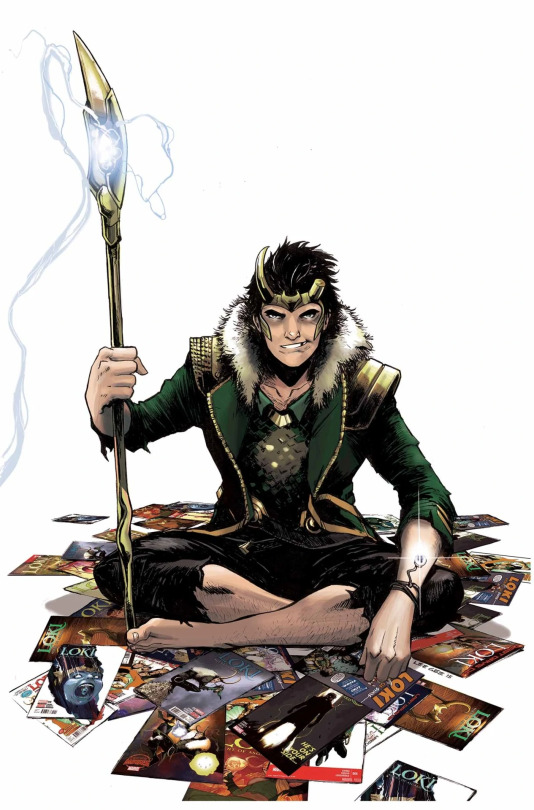
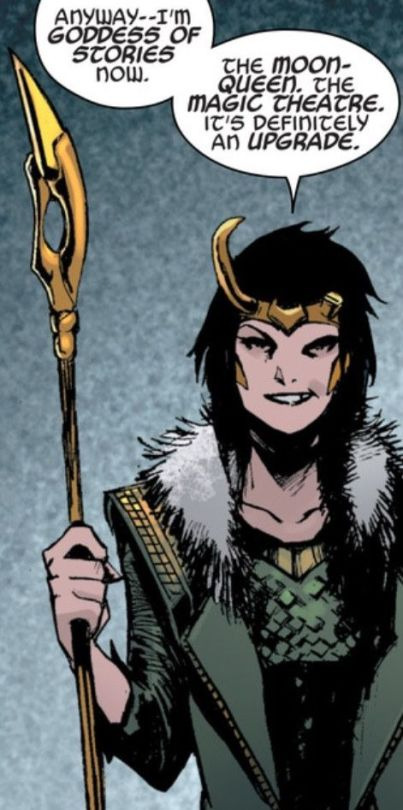
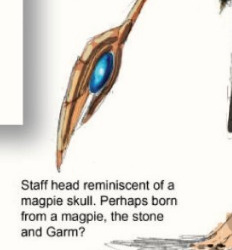
There was also some Thor Ragnarok concept art for possible Loki looks that had polearm weapons in them -- these are both by Aleksi Bricolet. (Also this one, but doesn't have a really good look at the polearm.)
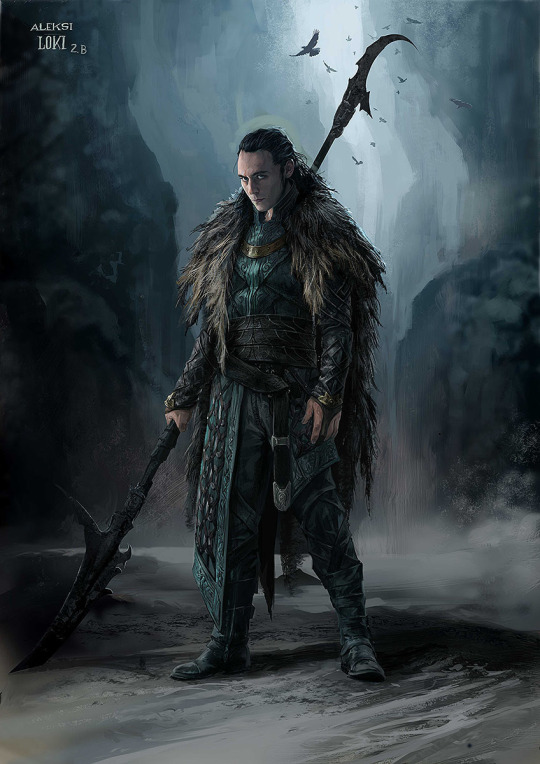
(source)

(source)
hopefully that helps!
23 notes
·
View notes
Text
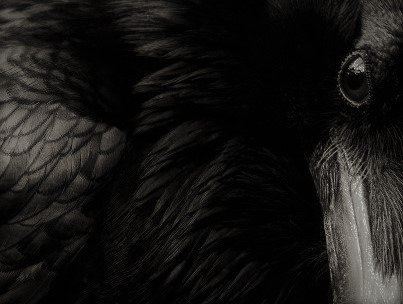
Odin
Norse god of wisdom, knowledge, poetry, war, victory, sovereignty, divination, and magick
One of Odin’s countless titles is “All-father” (Old Norse: Alfaðir), since he is essentially the father of all of the Norse gods and was believed to be the divine ancestor of countless families from all over northern Europe. He is simultaneously an Aesir god, a Vanir god (the Vanir god Odr is only an extension or transposition of Odin), and a jötunn (ancient giant). Odin’s mother, Bestla, was one of the first frost-giants. One Old Norse poem even identifies him with önd, the breath of life. Furthermore, Odin is also the discoverer of the Runic alphabet and is married to the mother-goddess Frigg.
Appearance and Roles: Old Norse texts portray Odin as one-eyed and long-bearded, frequently wielding a spear named Gungnir and wearing a cloak and a broad hat. One of the most striking attributes of his appearance is his single, piercing eye. His other eye socket is empty – the eye it once held was sacrificed by himself in order to gain wisdom. Odin is often accompanied by his animal companions and familiars—the wolves Geri and Freki and the ravens Huginn and Muninn, who bring him information from all over Midgard—and rides the flying, eight-legged steed Sleipnir across the sky and into the Underworld. Odin is the son of Bestla and Borr and has two brothers, Vili and Vé. Odin is attested as having many sons, most famously the gods Thor (with Jörð) and Baldr (with Frigg), and is known by hundreds of names. In these texts he frequently seeks greater knowledge, at times in disguise (most famously by obtaining the Mead of Poetry), makes wagers with his wife Frigg over the outcome of exploits, and takes part both in the creation of the world by way of slaying the primordial being Ymir and in giving the gift of life to the first two humans, Ask and Embla. Odin has a particular association with the festival of Yule, and mankind's knowledge of both the runes and poetry is also attributed to him.
Old Norse texts also state that female entities connected with the battlefield—the valkyries—were led by Odin, since he oversees Valhalla, where he receives half of those who die in battle, the einherjar, the honourable warriors. The other half are then claimed by the goddess Freyja for her afterlife location, Fólkvangr. Odin also is said to consult the disembodied, herb-embalmed head of the wise being Mímir for advice, and during the foretold events of Ragnarök Odin is told to lead the einherjar into battle before being consumed by the monstrous wolf Fenrir. In later folklore Odin appears as a leader of the Wild Hunt, a ghostly procession of the dead through the winter sky. He is also associated with charms and other forms of magic, particularly in Old English and Old Norse texts.
As a god of sovereignty, Odin is paradoxically also the favourite god and helper of outlaws, those who have been banished from society for some especially heinous crime, as well. Like Odin, many such men were exceptionally strong-willed warrior-poets who were apathetic to established societal norms – Egill Skallagrímsson (Egil’s Saga) and Grettir Ásmundarson (The Saga of Grettir the Strong) are two examples. The late twelfth/early thirteenth-century Danish historian Saxo Grammaticus even relates a tale of Odin being outlawed from Asgard for ten years so that the other gods and goddesses wouldn’t be tarnished by the vile reputation he had acquired amongst many humans. Whatever their social stature, the humans favored by Odin are distinguished by their intelligence, creativity, and competence in the proverbial “war of all against all”. For Odin, any kind of limitation is something to be overcome by any means necessary, and his actions are carried out within the context of a relentless and ruthless quest for more wisdom, knowledge, and power, usually of a magical sort.
Odin’s competitive side once drove him to challenge the wisest of the jǫtnar (giants) to a contest to see who was more knowledgeable. The reward was to be the head of the loser, and Odin won this challenge by asking his opponent something that only he himself could know. Odin then claimed his prize and returned to Asgard. Along with Freyja, he is one of the two greatest practitioners of shamanism amongst the gods. The Ynglinga Saga records that Odin often “travels to distant lands on his own errands or those of others” while he appears to others to be asleep or dead. Another instance is recorded in the Eddic poem “Baldur’s Dreams,” where Odin rode Sleipnir, an eight-legged horse, to the Underworld in order to consult a dead seeress on behalf of his son. Odin’s mastery of necromancy, the magical art of communicating with and raising the dead, is frequently noted. While there are several reasons Odin maintains this commerce with the dead, including his desire to learn what knowledge and wisdom they possess, the most significant reason is his dread-driven desire to have as many of the best warriors as possible on his side when he must face the wolf Fenrir during Ragnarok – even though he knows that he’s doomed to die in the battle.
Myths: In myth, Odin needed to make a sacrifice of himself in order to obtain great wisdom. This myth displays the great desire for knowledge and wisdom Odin holds, as well as his unstoppable will-power. Odin All-Father was troubled deeply for the whisperings of the Yggdrasil tree had told him the prophecies of the end, of Ragnarök. He had listened and knew of how Surtr the Black would join the giants in their war against the gods, how he would arise out of the flames of Muspell and drown the earth in fire. Odin’s wisdom told him that he could not prevent this end, but he hoped that perhaps, with wisdom, something could be done to have some gods and humans to survive. Odin travelled the Bifrost to Midgard and began to search for the well of Mimir. The well lay beneath the root of Yggdrasil that grew out of Jotunheim. It was kept my Mimir, the man who drank its wisdom each morning and who kept watch over the Gjallar-horn that Heimdallr, the white watcher, will blow on the day of Ragnarök.
After many days of travel, Odin came to the edge of the well deep in Jotunheim. Mimir approached him and took up the horn Gjallar and filled it with good water from the well and gave the horn to Odin to drink. As he drank, his eyes opened and saw visions of great and terrible sufferings that would befall both men and gods. He drank again and saw the ways that gods and men might, in great noble courage, fight and defeat the evils that would surely arise, though at great cost for he saw also his death and the death of the Aesir that lived in Asgard by his side. How mighty Thor would succumb to the venom of the great serpent, and how Loki would come against Heimdallr and would kill one another, he saw his own defeat at the jaws of Fenrir, and many more deaths and failings that would come of Ragnarök.
After witnessing these things, Odin put his hand to his face and plucked out his right eye. The pain was great and searing, but he made no sound nor showed his great suffering. Mimir took the eye and threw it into the well where it sunk deep but glistened like glass, a sign to any who might pass of the price Odin All-Father paid for his wisdom. And Odin returned to Asgard and sat upon his throne and considered the things he had seen.
In another myth, Odin underwent a ritual death and rebirth in order to discover the runes. At the centre of the Norse cosmos stands the great tree Yggdrasil. Yggdrasil’s upper branches cradle Asgard, the home and fortress of the Aesir gods and goddesses, of whom Odin is the chief. Yggdrasil grows out of the Well of Urd, a pool whose fathomless depths hold many of the most powerful forces and beings in the cosmos. Among these beings are the Norns, three sagacious maidens who create the fate of all beings. One of the foremost techniques they use to shape fate is carving runes into Yggdrasil’s trunk. The symbols then carry these intentions throughout the tree, affecting everything in the Nine Worlds. Since the runes’ native home is in the Well of Urd with the Norns, and since the runes do not reveal themselves to any but those who prove themselves worthy of such fearful insights and abilities, Odin hung himself from a branch of Yggdrasil, pierced himself with his spear, and peered downward into the shadowy waters below. He forbade any of the other gods to grant him the slightest aid, not even a sip of water.
And he stared downward, downward, and called to the runes. He survived in this state, teetering on the precipice that separates the living from the dead, for no less than nine days and nights. At the end of the ninth night, he at last perceived shapes in the depths: the runes. They had accepted his sacrifice and shown themselves to him, revealing to him not only their forms, but also the secrets that lie within them. Having fixed this knowledge in his formidable memory, Odin ended his ordeal with a scream of exultation. Having been initiated into the mysteries of the runes, Odin recounted:
“Then I was fertilized and became wise;
I truly grew and thrived.
From a word to a word I was led to a word,
From a work to a work I was led to a work.”
Equipped with the knowledge of how to wield the runes, he became one of the mightiest and most accomplished beings in the cosmos. He learned chants that enabled him to heal emotional and bodily wounds, to bind his enemies and render their weapons worthless, to free himself from constraints, to put out fires, to expose and banish practitioners of malevolent magic, to protect his friends in battle, to wake the dead, to win and keep a lover, and to perform many other feats like these.
Personality: In my personal experiences with Odin, he is withdrawn, reclusive, analytical, methodical, studious, very serious, loves riddles and numbers, is a physiomancer (can divine the future through many methods), and takes oaths very seriously, rarely forgiving anyone who breaks them. He can help with many things, including gaining wisdom and knowledge, magickal prowess, divination, shamanism, spiritual rebirths, cunning, and discovering what truly matters in life so we can move past lesser things. Odin says that he can also assist in protecting against the malicious god Loki, who tricks others into trusting him and then harms them unsuspectingly, or disguises himself as their loved ones in order to hurt them or get his way.
Offerings: beer (all types but prefers dark/stout), meat (pork, all game animals and birds), eggs, courgettis, oak, ash wood, runes, amber, lightning bolt imagery, any form of fortune telling tools (tarot, pendulum, etc.), crow/raven skulls or feathers, black silk, aubergine, wooden bowls, white sandalwood, black peppercorns, cedar, white daisies, cosmic tree imagery, crow/raven statuettes.
128 notes
·
View notes
Text
My Top Video Games of 2010s
Bolded = My GoTY
2010
999: Nine Hours, Nine Persons, Nine Doors
Alpha Protocol
Atelier Rorona
Castle Crashers
Chaos Rings
Deathsmiles
Donkey Kong Country Returns
Dragon Age Origins Ultimate Edition
Dragon Quest IX
Etrian Odyssey III: The Drowned City
Fairy Wars
Fallout: New Vegas
Guwange
Harvest Moon: Hero of Leaf Valley
Infinite Space
Knights in the Nightmare
Mass Effect 2
Mega Man 10
Mega Man Zero Collection
Monster Hunter Tri
No More Heroes 2
Pac-Man Championship Edition DX
Persona 3 PSP
Pokémon HeartGold/SoulSilver
Professor Layton and the Unwound Future
Sakura Wars: So Long, My Love
Scott Pilgrim vs. The World
Sengoku Basara: Samurai Heroes
Shin Megami Tensei: Strange Journey
Sin and Punishment: Star Successor
Splatterhouse
STALKER: Call of Pripyat
Super Mario Galaxy 2
Tatsunoko vs. Capcom
Xenoblade Chronicles
2011
Ace Combat: Assault Horizon Legacy
Dark Souls
Deathsmiles II
Dragon Quest VI
Hard Corps: Uprising
Harvest Moon: The Tale of Two Towns
Kirby's Return to Dreamland
Marvel vs. Capcom 3
Pokémon Black
Rayman Origins
Saints Row: The Third
Shin Megami Tensei: Devil Survivor Overclocked
Sonic Generations (HD)
Star Wars: The Old Republic
Ten Desires
The Witcher 2
Ultimate Marvel vs. Capcom 3
Valkyria Chronicles III
2012
Call of Duty: Black Ops II
Chaos Rings II
Dishonored
Dodonpachi Maximum
Dragon’s Dogma
Final Fantasy XIII-2
Growlanser: Wayfarer of Time
Gungnir
Harvest Moon: A New Beginning
Hatoful Boyfriend
Long Live the Queen
New Super Mario Bros. 2′s coin rush mode
New Super Mario Bros. U
Pokémon Black 2
Professor Layton and the Miracle Mask
Puzzle & Dragons
Shin Megami Tensei: Devil Survivor 2
Spelunky
Sumioni: Demon Arts
Transformers: Fall of Cybertron
Twisted Metal
Way of the Samurai 4
Xenoblade Chronicles
Zombi U
2013
Batman: Arkham Origins Blackgate
Deus Ex: Human Revolution-Director’s Cut
Double Dealing Character
Dragon's Crown
Dungeon & Dragons: Chronicles of Mystara
Dynasty Warriors 8
Papers, Please
Rayman Legends
Rogue Legacy
Rune Factory 4
Shin Megami Tensei IV
Tales of Xillia
The Cave
The Legend of Zelda: A Link Between Worlds
The Stanley Parable
2014
Atelier Escha & Logy
Broken Age
Divinity: Original Sin
Donkey Kong Country: Tropical Freeze
Dragon Quest IV (iOS)
Dynasty Warriors 8 Xtreme Legends Complete Edition
Final Fantasy X/X-2 HD Remaster
Mario Kart 8
Persona Q: Shadow of the Labyrinth
Phoenix Wright trilogy
Pokémon ORAS
Professor Layton and the Azran Legacy
Super Smash Bros. 4 3DS
Tales of Symphonia Chronicles
Tales of Xillia 2
The Last of Us Remastered
Ultra Street Fighter IV
2015
Ace Combat: Assault Horizon Legacy
Bloodborne
Broken Age: The Complete Adventure
Dariusburst Chronicle Saviors
Legacy of Lunatic Kingdom
Pillars of Eternity
Rare Replay
Shin Megami Tensei: Devil Survivor 2 Record Breaker
Shovel Knight [Xbox One]
Story of Seasons
Super Mario Maker
The Age of Decadence
The Witcher 3
Undertale
Until Dawn
Way of the Samurai 4
Yakuza 5
Yoshi's Woolly World
2016
Deus Ex: Mankind Divided
Dishonored 2
Killer Instinct: Supreme Edition
Pac-Man Championship Edition 2
Pokémon Sun/Moon + Special Demo
Super Robot Wars Original Generation: The Moon Dwellers
The Witcher 3: Game of the Year Edition
Touhou Genso Rondo: Bullet Ballet
Tyranny
2017
ARMS
Crash Bandicoot N. Sane Trilogy
Cuphead
Divinity: Original Sin II
Hidden Star in Four Seasons
Horizon Zero Dawn
Mario Kart 8 Deluxe
Night in the Woods
Romancing SaGa 2
Sonic Mania
Star Fox 2
Story of Seasons: Trio of Towns
Super Mario Odyssey
The Legend of Zelda: Breath of the Wild
Wonder Boy: The Dragon's Trap
2018
428: Shibuya Scramble
Bloodstained: Curse of the Moon
Dead Cells
God of War
Hyrule Warriors: Definitive Edition
Kingdom Come: Deliverance
Monster Boy and the Cursed Kingdom
Pillars of Eternity 2: Deadfire
Shin Megami Tensei: Strange Journey Redux
Sonic Mania Plus
Street Fighter V: Arcade Edition
Super Robot Wars X
Super Smash Bros. Ultimate
The Walking Dead: The Final Season
Thronebreaker: The Witcher Tales
Vampyr
Yakuza 0
Wario Ware Gold
2019
Castlevania Anniversary Collection
Collection of Mana
Darius Cozmic Collection (International/Special Edition)
Disco Elysium
Dragon Quest XI S
Fire Emblem: Three Houses
Pathologic 2
Romancing SaGa 3
SaGa: Scarlet Grace
Sekiro
Shovel Knight: Showdown
Six Ages
Space Invaders Invincible Collection
Spyro Reignited Trilogy
Star Ocean: First Departure R
Super Mario Maker 2
Super Robot Wars T
Tetris 99
Wily Beast and Weakest Creature
Misc.
Any Super Robot Wars game translated (official or fan)
5 notes
·
View notes
Text
Eddic [Mythology of All Races Vol. 2] Chp IV: Odin

A few personal notes for me to keep in mind. This is all from the book, Eddic: Mythology of All Races by Matthew MacCollogh. Nothing is outside of this. Furthermore I’m sure there is content in here that can be debated.
Other names:
Wodan wōd: mad
OHG woutan
OS wodan
AS Woden
ON O penn ON: poetic frenzy
Furious Host (?)
Other Norse Names:
Vafud
Vegtam (Wanderer)
Gangler (Traveler)
Ómi (Noist one)
Vidforull (Fartraveler).
Viator Indefessus (Unwearied traveler) by Saxo.
Heimskringla (The far have travelled) by Snorri.
Galga Valdyr (Lord of the Gallows)
Hanga-tyr (God of the hanged).
Hnikar (Thruster).
Karl af berge (The man of the mountain).
Rostarus.
Drauga Drottim (Lord of Ghosts).
Valgautr (God of the Slain).
Val-Fadir because ‘all that fall in battle are sons of his adoption. Oski Synir (Snorri)
Valkjosandi (Chooser of the Slain) in (Kormaks-saga).
Hropt.
Fjolnir (The many shaped).
Bolverk.
Sigfadir (Father of Victory)
Sigtyr (God of Victory).
Hertyr (God of hosts).
Heryan (Leader of hosts).
Herfadir (Father of hosts).
Valfadir (Father of the slain).
Hnikarr (Spear-lord).
Biflindi (Spear Brandisher).
Gautatyr (God of the Gauts).
Saxagod (God of the Saxons).
Aldafadie (father of men).
Grimnir (the hooded one).
Hrafna-god (Raven god).
All Father and patron of aristocracy, warriors and skalds.
Hyndlujod, Freyja says he gives hold, Hermod helm and coat of mail, to Sigmund a sword, and triumph to some.
Oaths were sworn by Sigtyr’s Mountain, his city was Sigtun.
Odin drinks wine.
The first drink is to Odin ‘for victory and power.’
The other gods are Odin’s people as he rules all things.
Grants men their wishes.
War god
Weapons and armour to heroes.
Dog was given his spear.
Heroes valour, triumph and treasure.Women and giantesses made victims by his runes.
Caused the first war between the Aesir and Vanir.
‘He hurled his spear on the host, and war then came first into the world.’ (Voluspa).
Also pisses off princes, kings and causes strife.
Provoked battle of Harald and Ring.
Pisses off easily when victory is given to the wrong places such as Brynhild and Agnar (Svefnthorn).
Joins in battle and has favourites, so people favour him.
Great warrior.
Weapons reference Odin and his Valkyries.
More prominent than Thor.
Likewise his spear is of better 'culture’ than Thor’s hammer.
Ravens haunting the battlefield equate to him.
Spear Gungnir made by dwarfs and given to him by Loki.
All other weapons were useless against it.
God of poetry, master of magic, knowledge.
Odin gives poets their words by taking poetic mead from the giants.
Gave Starkad the art of poetry and composition of spell.
Appears in dreams before great battles to give some victory and invite others to him. (Snorri)
Spoke magic and charms to the Volva but did not know Balder’s fate-- had to seek knowledge from her.
Struck Rinda with a bark of runes and drew her into a frenzy.
Loki accuses him of dressing as a witch and working charms in Samsey.
Obtained a magic wand gambantein and learned a language from the dead in Hlebard in Harbardsljod.
Cures a lame horse with charm or rune.
Knows magic songs bringing sickness, sorrow, stop arrows, produce fetters and blunt weapons, neutralizer dangerous roots where runes are written and reflect the danger, remove hatred, calm wind, aid friends in a fight, make the hanged speak, quench fire, give knowledge of the gods and elves and win love.
Takes form of a ferryman, a servant or peasant, snake, eagle.
Woke the dead and sat under hanged men for knowledge. (Ynglinga-saga)
Could control fire, sea and wind by his words.
Knew of buried treasure, runes to open earth, mountains, rocks and mounds. Could also bind these.
May understand the language of birds.
Runes
May have created runes in Havamal.
Coloured them perhaps with blood.
Could have obtained the wounds by hanging on Yggdrasil and wounding himself by his spear as an offering to himself. The runes may have fallen down from the tree.
Consults Mimir.
Made runes of draught from head of Heithdraupnir and horn of Hoddrofnir.
Mimir may be a waterspirit with his well beneath a root of Yggdrasil.
Wisdom and understanding are stored under Yggrasil
Loss of his eye! Mimir withheld a drink from the well until he was given.
Odin’s eye is hidden in the well where Mimir drinks of the pledge each day.
Could perhaps be Odin’s uncle, son of Bolthorn who is the father of Bestla who is Odin’s mother.
More Wisdom
Drinks daily from the cool waves of Sokkvabekk with gold cups with the Goddess Saga (Frigg?)
Saga is a female water elf.
Love affair (?).
Sought to match his knowledge with the giant Vafthrudnir. Proved himself wiser.
“What did Odin speak into Balder’s ear before he was burned on the pyre?” A riddle used with both th giant and King Heidrik during Yule.
Initially a spirit of god of wind or dead as the past wandered in the wind. Brings wind with his wagon.
Gives fair winds to sailors as said by Freyja in Hyndluljod.
The storm stills when Odin boards Sigurd’s ship.
May have first been worshipped in Gotland.
Is a traveler.
Rides a white or black horse with a wide brimmed hat, staff and hounds.
Snorri: rides with helmet, birnie and speak Gungnir at Ragnarok.
Also known to ride Sleipnir. The eight legged grey mare of Loki’s lineage with Svadilfari.
Rides her to Urd’s well daily.
To consult Volva in Niflhel about Balder’s dreams.
To offer random for Hel after his death.
Names stemming from appearance:
Sidhottr (with broad hat).
Harbard (grey beard).
Skidskegg (long beard).
Misc about appearance
A man of amazing height (Saxo).
Draupnir, the ring made by Sindri the dwarf was given to Odin by his brother.
Burned with Balder’s pyre and Balder sent it back to him from Hel.
Animals of Odin.
Munnin (Memory) and Huginn (Thought) are sent at day break around the world and return at evening to bring news to him.
Whisper what they have heard.
All Ravens are birds of Odin.
Wolves are also his: Geri ‘The Ravener’ and Freki ‘The Glutton’
Shares food and wind with him.
Sleipnir is taken to Hel, Jotunheim, etc.
Challenged Hrungnir that his was better than Gullfaxi.
Hrungnir chased him into Asgard where Thor dealt with him.
Yggdrasil
‘Ygg’s Horse’ Ygg being “The terrible”.
Askr Yggdrasils (the ash of Yggdrasil or of Odin’s steed).
Odin hung for nine nights in Havamal.
Stabbed himself with his own spear as well.
King Vikar needed to sacrifice himself so that his fleet might pass through great storms.
Starkad (Odin’s foster son) created a death akin to Odins for Vikar.
Harbard
Appears as a ferryman of the dead.
Valhalla
“Souls of those slain by violence go in the Furious Host, and souls of heroes go to Odin in Valhall.” (MacCulloch, 44).
Chosen warriors are einherjar.
Mightiest of warriors are taken to Valhalla as he wants them by their side when Fenrir comes to the seat of the god.
Valhalla lies in Gladsheim, the world of joy.
Valhall is the ‘Hall of the Slain’.
Vingolf is the ‘friendly floor.’
Valkyries
‘Chooser of the Slain,’
However shares the slain with Freyja.
Determine a man’s feyness and awarded victory and took the slain.
Wish-Maidens becausee they carried out Odin’s will.
Corselets sprinkled with blood and sparks fly from their spears.
Sacrifice
Prisoners sacrificed more common in Denmark and Sweden. ‘Odin has you all!’
In response Odin gives some gifts at times.
Descent
The cow Audhumla gave birth to Buri.
His son was Borr who married Bestla.
Bestla was daughter of Bolthorn.
Bestla and Borr had Odin, Vili and Ve.
Children and Love
Frigg.
Wife of Odin, although she was at one point shared with Vili and Ve when they believed Odin would not return.
Frigg offending Odin may have been why he left.
Or perhaps thrown out into exile after the incident with Rinda.
Took her back as his wife when he came back.
Son was Balder
Jord
Son was Thor.
Rinda.
After Balder died, Odin desired revenge. So he spoke to prophets on this and one of these told him a son must be born to him by Rinda. As a soldier, he gained her father’s favour but not Rinda. As a smith he made Rinda made many things but she still refused him. Eventually, he used the bark of runes and claimed to cure her as a maiden skilled in Leecraft.
Has Vali by her (Bous in Eddas).
Seven sisters in Harbardsljod. Allures witches from their husbands.
Linen-White Maid.
Grid
Has Vidarr by her.
Billings Daughter
“Dear to him as life.”
Tried to visit her at night on her request only to find a band of warriors at her home.
Visited her in the morning and found a dog tied to her bed.
“Many maids are fickle.”
Gunnlod, daughter of the giant Suttung.
Penetrated rock with the snout of Rati.
Mead given to him by Gunnlod and he won her over.
‘fettered with the feathers of the bird of forgetfulness (heron) in Gunnlod’s abode, very drunk in the house of wise Suttung.’
Gains knowledge from the mead.
As Bolverk, he slept with her for three nights and received three draughts of mead. He gave the first to Odrorir, second to Bodn and third Son to gain all the mead.
Then turned into an eagle and flew away beck to Asgard.
Gave the mead to the Aesir, who have the ability of composition. Poetic Mead.
Other Children
Heimdall
Bragi
Hod
Skjold
Kings and chiefs (Skjoldings from his son Skjold)
Losses
After killing Otter he had to pay wergild when overcome by Hreidmar.
“In Lokasenna, Odin shows himself frightened for Loki, and it is Thor, not Odin, who silences him.” (MacCullogh, 49)
Source Credit
MacCulloch, John Arnott. The Mythology of All Races: Eddic. Vol. 2, Cooper Square Publ., 1964.
16 notes
·
View notes
Text
Tangent Time: Óðinn
Personally, I’ve never been able to picture Óðinn in armor. No matter how many pieces of (admittedly excellent and wonderfully executed) art I see with him bedecked in the regalia of war, it always causes a severe cognitive dissonance. My brain (or maybe even my soul?) just outright rejects images of Óðinn as anything other than the wanderer.
Sure, it seems weird from the onset. Of all his multifaceted dealings, he is heavily invested in war, battle, hangings, ravens and wolves, and all kinds of things linked to violent death. Why wouldn’t he ever gear up?
The scene of Sigmund in battle against the forces of King Lyngvi hit me hard. It solidified everything I’ve ever felt about Óðinn on the battlefield. (Granted, depictions in sagas I’ve yet to read may still sway me, but… I seriously need to fan-girl over this.)
“Now when the battle had gone on for some time, a man who had on a black cloak and a hat coming down low over his face entered the fray. He had but one eye and in his hand he held a spear. The man advanced towards King Sigmund, raising the spear to bar his way, and when King Sigmund struck fiercely, his sword hit against the spear and snapped in two.” [Finch, 1965]
There’s no glorious descriptions of a gleaming helmet, or thousands of flames glinting off of chain-mail, or the sun shining off a polished shield.
Just an old, shadowy man in a cloak and hat walking calmly amongst the chaos and fury of the battle. Warriors locked in violent contest unconsciously move aside, not breaking their combat, just unnaturally clearing a path. What few even notice him can only recall it like a hazy dream afterwards. Even the slain seem to avoid his footfalls. He simply strolls through the empty space around him, Gungnir slung casually over his shoulder. The raging warriors clashing back together in his wake. Then he sees Sigmund, his great-great-grandson. The king saw the old man, he was almost the only thing that Sigmund could see. So Sigmund charges and strikes, and Gungnir stops the sword, shattering it. The old man fades away like a lost memory.
This is just… excessively bad-ass.
384 notes
·
View notes
Text
Mjolnir/Mjölnir, The Hammer of Thor: Meaning and Symbolism in Norse Mythology
Mjolnir, the Hammer of Thor is undeniably one of the most popular fictional objects in popular culture today. It has been helped in no small part to that position by the spectacular success of the Avengers movie series and especially the popularity of Thor, the Norse god who wields it.
However, as is all too often the case with the Hollywood version of anything it portrays, almost everything the layperson learns about this mythological object by watching the films, from the story of its origins to the magical properties with which it is imbued, differs significantly from the original source material.
The Mjolnir/Mjölnir is actually part of the Norse mythology of the peoples of Scandinavia and tales of its creations and marvelous feats are about a thousand years old. The name, ‘Mjolnir’ is commonly accepted to mean ‘Lightning’ in the capacity as the hammer of the God of Thunder but the root word is more similar to the words ‘grind’ or ‘crush’.
Here, we delve into both the original myths that entranced the Norse people over centuries, and their modern counterparts created by storytellers today which are based loosely on those originals.
The Mjölnir in Norse Mythology
The gods and goddesses of Norse mythology are rich, multi-layered characters, significantly more nuanced and ambiguous than their black-and-white depictions as heroes or villains that we see in Hollywood movies.
Most people are shocked to learn that the mighty Hammer of Thor was created not at the behest of a ‘good guy’ character liked Odin, Thor’s father, but by Loki, who is seen as Thor’s arch rival. Norse storytellers did not paint Loki as a villain per se but rather as a mischievous character; in fact, he is known as ‘The Trickster’ in the tales of old.
The story of the origin of Thor’s Hammer begins with Loki in an especially impish mood. While larking about, he decides to shave off the prized blonde tresses of Sif, Thor’s wife. The God of Thunder, always quick to ire and already sharing an acrimonious relationship with his brother, seizes Loki and is about to kill him when Loki pleads for a chance to redeem his wrong.
He proposes to travel all the way to Svartalfheim, home of the Dwarves, deep under the ground. The Dwarf race were regarded as master craftsmen and Loki suggested that they would be able to fashion a new head of golden hair for Sif more beautiful than the one he ruined. Thor spares him upon that promise and the irreverent god makes his way to Svartalfheim.
There, the sons of the dwarf Ivaldi with their vast talents did manage to create new golden locks for Sif, as well as Skidbladnir, a ship whose sails always swelled with a favorable wind and which could be folded up to fit in a pocket, and Gungnir, the deadliest of all spears.
Loki’s roguish impulses could always be counted on to find sport in any circumstance, and instead of leaving for Asgard with the three worthy treasures, he decided to indulge in his usual passion for trickery and mischief. Showing the golden tresses, ship and spear to two other Dwarf brothers, Brokkr and Sindri (or Etiri), he taunted them saying they could not match that level of craftsmanship.
The brothers accepted the challenge on a wager – if the gods in Asgard judged their creations to be superior to those of the sons of Ivaldi, they would have Loki’s head in return. Loki, complacent in the belief that the treasure he held could not be bested, amiably agreed.
Brokkr and Sindri made three magical masterpieces of their own. The first was Gullinbursti, a living boar with golden hair that gave off light in the dark and could run better than any horse through land, water or air. The second was Draupnir, a ring from which fell eight new golden rings of equal weight every ninth night.
The third was Mjölnir.
Apart from its exquisite craftsmanship, Mjölnir was created with spells that ensured that it would never miss its mark, and that it would always rebound back to its wielder. When the two dwarves presented them to the gods, Odin declared their creations superior to those of the Sons of Ivaldi. The hammer was presented to Thor in his capacity as defender of Asgard.
Thus, there was once a time when the character of Thor did not wield the Hammer that has become virtually synonymous with his name. Once it was in his hands, though, it is said that they will not be separated until the cataclysmic events of Ragnarok foretold in the Norse sagas.
We must remember, though, that it is a critical element of the way that the Norse sagas were constructed that duality and dichotomy were always an integral element of the narrative. The Hammer of Thor, for all its destructive power and primary role as a weapon of war, is also a tool of rejuvenation and regeneration, and the catalyst for the rebirth of the world after Ragnarok.
Mjölnir in Popular Culture
It is perhaps quite unfortunate that the image of the Mjolnir in popular culture has been molded from movies and comics rather than a reading of the original Norse sagas. However, it is also probably true that without those forays into popular media, the Norse gods, goddesses and their stories would never have entered the popular consciousness to the extent that they have.
There are actually three different origin stories for the Hammer of Thor in the comic world (upon which the movies starring Chris Hemsworth as Thor are based).
They all maintain that Mjolnir was crafted by Dwarven blacksmiths, but crucially also introduce the fictional element uru, a metal described as native to the Asgardian plane. Perhaps more importantly than any of the other variations from the original, the Hammer of Thor in the Marvel world carries an inscription on its side which reads:
Whosoever holds this hammer, if he be worthy, shall possess the power of Thor.
The use of uru and the inscription are both plot devices that allow storylines which imbue the hammer with fantastical properties and create a variety of interesting story webs.
The Three Versions
The first and earliest version is virtually identical to the one found in the Norse saga; it does not differ dramatically from the tale told by the Norsemen of old because the authors tried to incorporate elements and characters from the original to create a tangible link between old and new.
The only significant difference was that Odin, the king of the Norse gods who was also known as Woden or Wotan wielded Mjolnir first, and only passed the hammer to Thor after the latter proved himself worthy.
The second version from the comics is the one incorporated into the storyline of the Thor movies starring Chris Hemsworth. In it, Mjolnir is created by the Dwarf blacksmiths Brock, Etiri and Buri upon the orders of Odin.
They craft it in an enchanted forge inside a dying star using a process is so powerful that it destroys the star and causes the cataclysmic events that wipe out the dinosaurs on Earth.
The third version speaks of a sentient being called the Mother Storm, a giant storm of galactic proportions that threatens Asgard. As king and defender of the realm, Odin engages it in battle, eventually defeating the mighty being and trapping it within a nugget of uru gifted to him by the Dwarven blacksmiths.
Wishing to harness its immense power as a tool and a weapon of war, Odin asked the dwarves to fashion the nugget into an object that he could wield. When the dwarves created Mjolnir upon his request, Odin found that he was unable to harness it with enough control for it to be a reliable asset.
He put the weapon aside and Mjolnir was forgotten for eons until Thor found it. He was able to lift the magical object, making it his personal weapon. This earned Mjolnir the moniker ‘Hammer of Thor’.
The Fantastic Abilities of Mjolnir
One of the most interesting elements of the modern legend behind the Hammer of Thor is that it cannot be lifted by an individual who is not pure of heart.
Forget the villains, even the most powerful and mighty of the heroes of the Marvel universe have been left found wanting in this regard. Certain individuals have been successful on occasion, and they include Superman, the Incredible Hulk and Thor’s grandfather, Bor.
For others, Mjolnir is simply an infinitely-heavy hammer-shaped object. Thor has, on several occasions, used this fantastic characteristic of his weapon to imprison his foes by simply placing it on them, rendering that individual immediately immobile.
Mjolnir as a Weapon and Tool
Mjolnir can be wielded as both an offensive and a defensive weapon. Possessing sufficient power to level mountains, it can emit blasts of mystical energy, control the electromagnetic force around an object, manipulate matter at a molecular level and generate powerful shockwaves that harness a planet’s gravitational force.
It also has the ability to generate a force field strong enough to contain an explosion so powerful that it is capable of destroying a galaxy, deflect and counter any offensive force and spontaneously destroy undead creatures like vampires.
The Hammer of Thor also possesses a variety of virtually limitless abilities including the creation of antimatter particles, tracking an individual or object, absorbing radioactive energy, detecting and projecting illusions, and can even summon the spirit of someone who swore upon it while alive.
Thor has used it for time travel and to manipulate the weather on a planetary scale, too. In some Marvel storylines, the Asgardian has used it to disguise himself in the appearance of a mortal, whereupon the Hammer projects itself as a walking cane.
The Hammer is intimately linked to Thor, and will fly back to his hands when summoned, even if it has to travel through entire planets on the way.
Can the Hammer of Thor Be Destroyed?
Its celestial origins imbue the hammer with virtual, but not complete, indestructibility. However, that leaves ample room for a variety of situations where Thor has been left stunned at the damage and even the complete destruction of Mjolnir.
The most iconic of these at this point is the trailer for Thor: Ragnarok, due for release in 2017. In it, one of Thor’s archrivals, the Asgardian Goddess of Death, Hela (portrayed by Cate Blanchett) is shown destroying Mjolnir during a battle with Thor.
How, or indeed if, Thor will be able to continue battle bereft of his primary weapon remains to be seen.
In the comic world, the Hammer of Thor has been damaged and destroyed a number of times. While it has survived bullets and anti-matter, force beams from Asgardian gods and goddesses, clashes against other uru weapons like those wielded by Loki’s Storm Giant army, and attacks from other celestial beings have left Mjolnir either in pieces or completely disintegrated.
One Marvel character, Molecule Man, even vaporized Mjolnir by destroying the bonds between the uru molecules that kept the relic together.
Mjolnir Today
The fascinating original and modern myths and legends behind Mjolnir, the Hammer of Thor, make it one of the most popular objects from the ancient world with which we are familiar today.
It is commonly worn as a symbol on rings and pendants by those who aspire to the noble qualities possessed by Thor, the Norse God of Thunder.
The post Mjolnir/Mjölnir, The Hammer of Thor: Meaning and Symbolism in Norse Mythology appeared first on Ragnar Lothbrok, Lagertha, Rollo, Vikings, Ouroboros, Symbols and Meanings.
Source: http://mythologian.net/mjolnir-hammer-thor-meaning-symbolism-norse-mythology/
0 notes
Photo
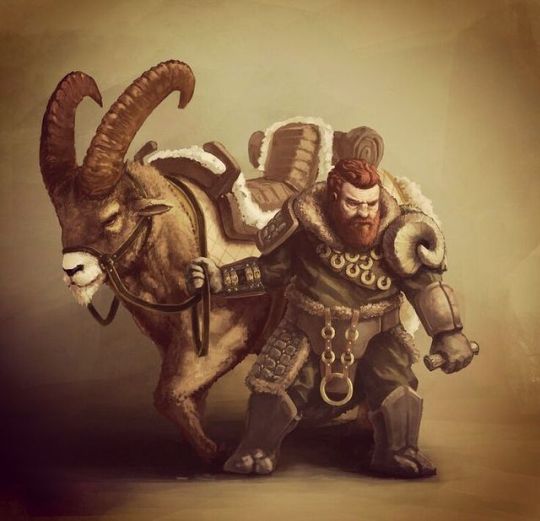
#Dwarf #dwarfism In Norse mythology, dwarves are highly significant entities associated with stones, the underground, and forging. Apart from the Eddas, they notably appear in the fornaldarsagas. They seem to be interchangeable, and may be identical, with the svartálfar (black elves), and sometimes the trolls (compare also with vetter, a class of beings from later Scandinavian folklore). The Völuspá divides the dwarves into what may be three tribes, lead by, respectively, Mótsognir,their first ruler; secondly Durinn, and finallyDvalinn, who according to the Hávamál brought them the art of rune writing. The dwarves are said to have come into existence while Odin and his brothers Vili andVé fabricated the world from the corpse of the cosmic giant, Ymir. They spontaneously generated, as maggots were thought to, in the dead flesh (earth or stone). The gods later gifted them with intelligence and human-like appearance. So it is said in the Völuspá: In Norse mythology dwarves are mostly seen as selfish, greedy, and cunning. They are skilled metal-workers and the makers of most of the artifacts of thegods, both Æsirand Vanir. Among their most famous creations are the spear Gungnir, and the golden ring, Draupnir, of Odin; Mjolnir, the hammer of Thor; the golden hair of Sif;Freyja's necklace, Brísingamen; and even the ship Skíðblaðnir of Freyr. The dwarves also fabricated a certain kind of helmet, calledhuliðshjálmr (concealing helmet), or sometimes a cloak, with which they could make themselves invisible. They are also vengeful and Hervarar saga relates that when king Svafrlami had forced the dwarves Dvalin and Durin to forge the magic sword Tyrfing, the dwarves cursed it so it would bring death to Svafrlami and cause three evil deeds. InYnglingatal, it is told how King Sveigder is lured into a stone by a dwarf.
0 notes
Text
Hey it's me I'm the person currently obsessed with sad Hibiki and Symphogear in general have some drawings of the girl!!!


Listen I really wanted the Black Gungnir to have more screentime so might as well give it to the edgy/depressed version of Hibiki I mean she fits the requirements to wield it.

This counts as art for my own fic so that's something too I guess!!!
Also what's with the overlap between Gundam fans and Symphogear fans what's the scientific explanation behind that?
#senki zesshou symphogear#symphogear#symphogear xdu#hibiki tachibana#tachibana hibiki#my art#i have the Symphogear sickness it's just as bad as the Gundam sickness#black gungnir saga
43 notes
·
View notes
Text
Guess who just spent 4 hours struggling to give Black Gungnir Hibiki a "final" design? Below are some design thoughts/processes over this whole ordeal:

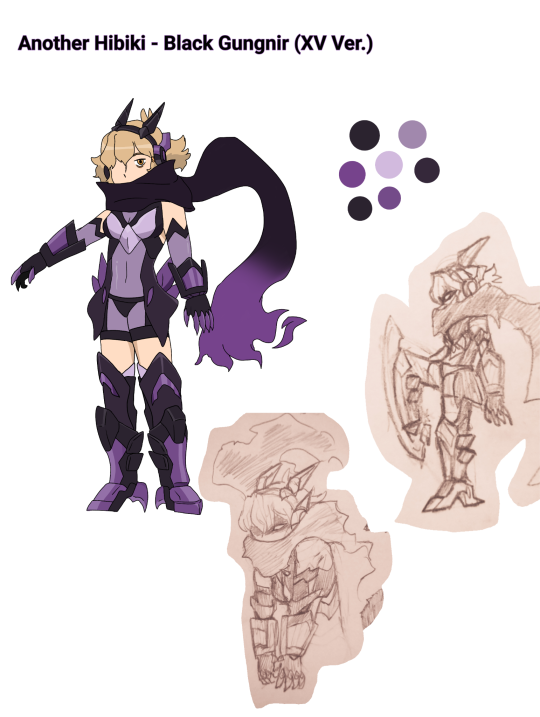
Thank god for Elekleid for giving Another!Hibiki purple/blue motifs because purple is a sick ass color and I went all into it for this design.
For this version of the Black Gungnir, I thought it would be fun if Hibiki can shape her burning scarf into her fists and release it in whips of dark flame to take down multiple Noise at a time, or use it as a cloak in the same vein that Canon Maria does. This is an expansion of an idea I had for Hibiki's spring claws idea, where when she pulls on her gauntlets instead of releasing energy it instead launches her claws like wires. Since they're smaller in this design, I figured the burning scarf's grapple whips would be a good stand in for that feature.
Where does the burning scarf come from? Probably as a symbol of overcoming her Berserk form? Still working on how that rationale works!
Since Hibiki is still a bit wary of people, she still has claws instead of fists as a part of her Symphogear, but they're significantly smaller than they were when she first unlocked it (see: older posts for that). Also, while her heel-claw can fold up, Hibiki's grown to use it a lot to ground herself for punches/scarf strikes or to stab Noise, so it mostly stays in heel shape even in the middle of combat.
I also really wanted to put in a bit of gold/orange on her design, but it clashed too much with the blacks and purples, so let's assume Saint-Germain decided to spare Hibiki from having a fashion flashbang Symphogear in this AU.
#symphogear#senki zesshou symphogear#symphogear xdu#hibiki tachibana#black gungnir saga#im retroactively naming these posts that btw#my art#purble#edgebikki
27 notes
·
View notes